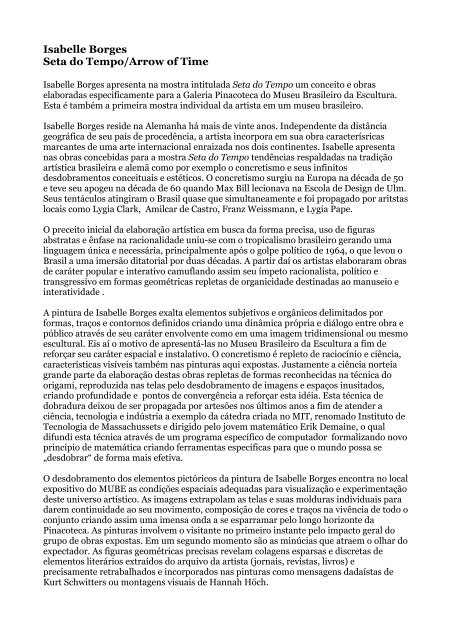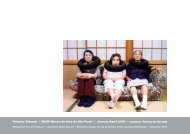Isabelle Borges - texto imprensa
Isabelle Borges - texto imprensa
Isabelle Borges - texto imprensa
You also want an ePaper? Increase the reach of your titles
YUMPU automatically turns print PDFs into web optimized ePapers that Google loves.
<strong>Isabelle</strong> <strong>Borges</strong><br />
Seta do Tempo/Arrow of Time<br />
<strong>Isabelle</strong> <strong>Borges</strong> apresenta na mostra intitulada Seta do Tempo um conceito e obras<br />
elaboradas especificamente para a Galeria Pinacoteca do Museu Brasileiro da Escultura.<br />
Esta é também a primeira mostra individual da artista em um museu brasileiro.<br />
<strong>Isabelle</strong> <strong>Borges</strong> reside na Alemanha há mais de vinte anos. Independente da distância<br />
geográfica de seu país de procedência, a artista incorpora em sua obra caracterísricas<br />
marcantes de uma arte internacional enraizada nos dois continentes. <strong>Isabelle</strong> apresenta<br />
nas obras concebidas para a mostra Seta do Tempo tendências respaldadas na tradição<br />
artística brasileira e alemã como por exemplo o concretismo e seus infinitos<br />
desdobramentos conceituais e estéticos. O concretismo surgiu na Europa na década de 50<br />
e teve seu apogeu na década de 60 quando Max Bill lecionava na Escola de Design de Ulm.<br />
Seus tentáculos atingiram o Brasil quase que simultaneamente e foi propagado por aritstas<br />
locais como Lygia Clark, Amilcar de Castro, Franz Weissmann, e Lygia Pape.<br />
O preceito inicial da elaboração artística em busca da forma precisa, uso de figuras<br />
abstratas e ênfase na racionalidade uniu-se com o tropicalismo brasileiro gerando uma<br />
linguagem única e necessária, principalmente após o golpe político de 1964, o que levou o<br />
Brasil a uma imersão ditatorial por duas décadas. A partir daí os artistas elaboraram obras<br />
de caráter popular e interativo camuflando assim seu ímpeto racionalista, político e<br />
transgressivo em formas geométricas repletas de organicidade destinadas ao manuseio e<br />
interatividade .<br />
A pintura de <strong>Isabelle</strong> <strong>Borges</strong> exalta elementos subjetivos e orgânicos delimitados por<br />
formas, traços e contornos definidos criando uma dinâmica própria e diálogo entre obra e<br />
público através de seu caráter envolvente como em uma imagem tridimensional ou mesmo<br />
escultural. Eis aí o motivo de apresentá-las no Museu Brasileiro da Escultura a fim de<br />
reforçar seu caráter espacial e instalativo. O concretismo é repleto de raciocínio e ciência,<br />
características visíveis também nas pinturas aqui expostas. Justamente a ciência norteia<br />
grande parte da elaboração destas obras repletas de formas reconhecidas na técnica do<br />
origami, reproduzida nas telas pelo desdobramento de imagens e espaços inusitados,<br />
criando profundidade e pontos de convergência a reforçar esta idéia. Esta técnica de<br />
dobradura deixou de ser propagada por artesões nos últimos anos a fim de atender a<br />
ciência, tecnologia e indústria a exemplo da cátedra criada no MIT, renomado Instituto de<br />
Tecnologia de Massachussets e dirigido pelo jovem matemático Erik Demaine, o qual<br />
difundi esta técnica através de um programa específico de computador formalizando novo<br />
princípio de matemática criando ferramentas específicas para que o mundo possa se<br />
„desdobrar“ de forma mais efetiva.<br />
O desdobramento dos elementos pictóricos da pintura de <strong>Isabelle</strong> <strong>Borges</strong> encontra no local<br />
expositivo do MUBE as condições espaciais adequadas para visualização e experimentação<br />
deste universo artístico. As imagens extrapolam as telas e suas molduras individuais para<br />
darem continuidade ao seu movimento, composição de cores e traços na vivência de todo o<br />
conjunto criando assim uma imensa onda a se esparramar pelo longo horizonte da<br />
Pinacoteca. As pinturas involvem o visitante no primeiro instante pelo impacto geral do<br />
grupo de obras expostas. Em um segundo momento são as minúcias que atraem o olhar do<br />
expectador. As figuras geométricas precisas revelam colagens esparsas e discretas de<br />
elementos literários extraídos do arquivo da artista (jornais, revistas, livros) e<br />
precisamente retrabalhados e incorporados nas pinturas como mensagens dadaístas de<br />
Kurt Schwitters ou montagens visuais de Hannah Höch.
Estas colagens foram primeiramente utilizadas por <strong>Isabelle</strong> <strong>Borges</strong> em desenhos tidos<br />
como rascunhos de pinturas a serem executadas. Estes porém atingiram relativamente no<br />
início de sua existência autonomia suficiente para serem vistos como obras únicas isoladas.<br />
Na mostra Seta do Tempo trazemos também pela primeira vez para o público brasileiro<br />
uma seleção destes desenhos, nos quais apreciamos claramente a evolução das formas, os<br />
contormos precisamente delimitados e incravados no suporte artístico, assim como a<br />
exata e delicada escolha da palheta de cores oscilando entre tons pastéis e cores primárias,<br />
criando um grande contraste e desconforto inicial devido à combinação inusitada. Esta<br />
seleção pictórica extrapola o suporte artístico e se espande pela galeria criando uma<br />
superfície e ambientação única.<br />
Seta do Tempo no Museu Brasileiro da Escultura espande a pintura de <strong>Isabelle</strong> <strong>Borges</strong> de<br />
tal forma a criar novas perspectivas espaciais e temporais a conduzir o visitante a uma<br />
imersão certeira.<br />
Tereza de Arruda, curadora<br />
Berlim, janeiro 2013<br />
<strong>Isabelle</strong> <strong>Borges</strong><br />
Arrow of Time<br />
<strong>Isabelle</strong> <strong>Borges</strong> presents a concept and works at the exhibition entitled Arrow of Time,<br />
developed specifically for the gallery Pinacoteca at the MUBE Brazilian Museum of<br />
Sculpture. This is also the artist’s first solo exhibition in a Brazilian museum.<br />
<strong>Isabelle</strong> <strong>Borges</strong> has been living in Germany for over twenty years. Regardless of the<br />
geographical distance from her country of origin, the artist incorporates tendencies into<br />
her work of a remarkable international art rooted in two continents. In the works created<br />
for the show Arrow of Time <strong>Isabelle</strong> displays trends related to the Brazilian and German<br />
artistic tradition such as Concrete Art and its infinite unfolding conceptual and aesthetic<br />
content. Concretism emerged in Europe in the 50’s and peaked in the 60’s when Max Bill<br />
taught at the School of Design in Ulm. Its tentacles reached Brazil almost simultaneously,<br />
the movement being propagated by local artists like Lygia Clark, Amilcar de Castro, Franz<br />
Weissmann and Lygia Pape.<br />
The initial precept of artistic elaboration in search of a precise form, the use of abstract<br />
figures and emphasis on rationality, teamed up with Brazilian Tropicalia to generate a<br />
unique and necessary language, especially after the political coup of 1964, which led Brazil<br />
to an immersion dictatorship for two decades. Since then artists have developed works of<br />
popular character and inteative, thus camouflaging the rationalist impulse, political and<br />
transgressive in geometric shapes filled with organic elements intended for handling and<br />
interactivity.
The painting of <strong>Isabelle</strong> <strong>Borges</strong> praises subjective and organic elements delimited by<br />
forms, traits and contours creating its own dynamics and dialogue between work and<br />
public through its character, as engaging in a three-dimensional image or sculptural. That<br />
is the reason for presenting her work at MUBE - Brazilian Sculpture Museum, to enhance<br />
its spatial and installation character. Concretism is full of reasoning and science, features<br />
also visible in the paintings exhibited here. Precise science guides much of the preparation<br />
of these works filled with forms recognized in the art of origami, reproduced on the canvas<br />
by scrolling images and unusual spaces, creating depth and focal points to reinforce this<br />
idea. This technique of folding is no longer only propagated by artisans. In recent years, it<br />
has been used as a method of research to meet science, technology and industry such as the<br />
chair created at MIT, renowned Massachusetts Institute of Technology and directed by the<br />
young mathematician Erik Demaine, who spreads this technique by means of a specific<br />
computer program formalizing a new principle of mathematical specific tools, so that the<br />
world can "unfold" more effectively.<br />
The unfolding of the pictorial elements of <strong>Isabelle</strong> <strong>Borges</strong> paintings finds suitable<br />
conditions at the MUBE exhibition hall for the visualization and experimentation of this<br />
artistic universe. The images go beyond the canvas and their individual frames to give<br />
continuity to its movement, color and composition traits in the whole context, creating a<br />
huge wave to spread along the horizon of the Pinacoteca. In the first instance, the paintings<br />
involve the visitor by the impact of the general group of works exhibited. Then it is the<br />
details that attract the eye of the viewer. The precise geometric figures reveal scattered and<br />
discrete collages out of literary elements taken from the artist's archive (newspapers,<br />
magazines, and books) and specifically reworked and incorporated into the paintings as in<br />
the dadaist messages of Kurt Schwitters or visual montages of Hannah Höch.<br />
These collages were first used in drawings by <strong>Isabelle</strong> <strong>Borges</strong>, taken as drafts of paintings<br />
to be executed. Early in their development, however, these reached relatively sufficient<br />
autonomy to be seen as unique isolated works. The exhibition Arrow of Time also brings a<br />
selection of these drawings to the Brazilian public for the first time. In them we clearly<br />
appreciate the evolution of forms, with the contours precisely delimited and inserted into<br />
the artistic support. In addition, the precise and delicate choice of color palette ranging<br />
between pastels and primary colors creates a great contrast and initial discomfort by its<br />
unusual combination. This selection goes beyond the pictorial and artistic support; it<br />
expands through the gallery creating a unique surface and ambiance.<br />
Arrow of Time at MUBE - Brazilian Sculpture Museum expands the painting of <strong>Isabelle</strong><br />
<strong>Borges</strong>, creating a new spatial and temporal perspective to guide the visitor to an accurate<br />
immersion.<br />
Tereza de Arruda, curator<br />
Berlin, January 2013







